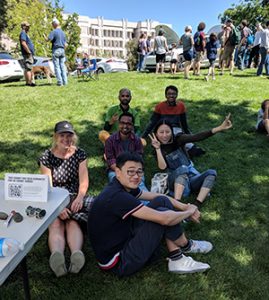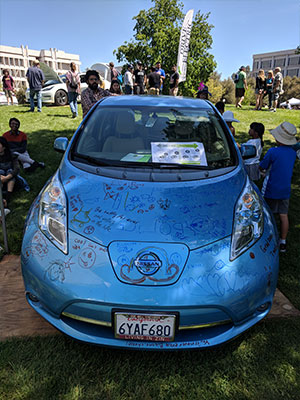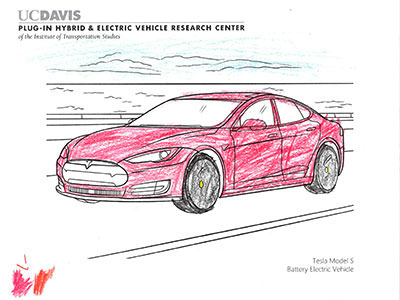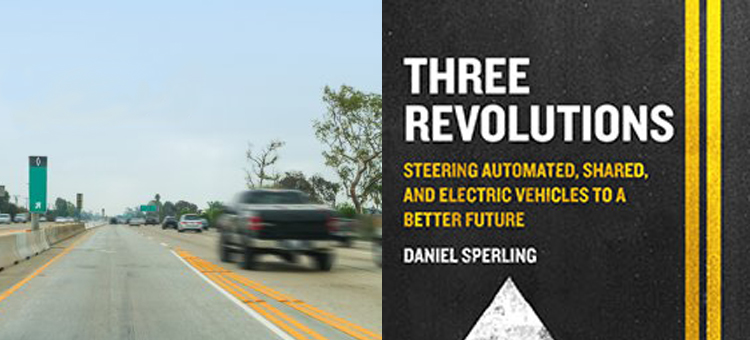Archives
Greenlight Blog: Global Electric Vehicle Sales are Accelerating, but Could Tariffs and Uncertain Policies Make it Hit the Brakes?
“Headlights” Newsletter Debuts, Illuminating the Latest from ITS-Davis

As the 2017-18 academic year concludes and summer begins, ITS-Davis has released the inaugural issue of Headlights.
Each issue of the newsletter will offer a snapshot of news and breakthroughs from ITS-Davis, the world’s leading university center on sustainable transportation.
The newsletter will spotlight our latest research, our student and faculty achievements, and where our experts are being quoted in news and broadcast media—and featured in podcasts and videos.
This first issue is especially “revolutionary.” In the spotlight are ITS-Davis Director Dan Sperling’s new book, and our 3 Revolutions Future Mobility Program. News from our affiliated and partner centers are also featured: the National Center for Sustainable Transportation, the Sustainable Transportation Energy Pathways Program (STEPS), the Plug-in Hybrid & Electric Vehicle Research Center, and the Policy Institute for Energy, Environment, and the Economy.
You can find the debut issue here.
Enjoy Headlights, and look for our next issue, this fall.
Note: To have the newsletter delivered to your mailbox, fill out our mailing list form, and check the box for Headlights, and other announcements you’d like to receive from ITS-Davis.
Transforming Travel: The ITS-Davis Graduate Student Recipients of Women in Transportation Scholarships
By Veronica Vargo

WTS Sacramento Chapter scholarship recipients (from left): ITS-Davis students Liya Jiao, Michelle Byars, Albee Wei, and Koral Buch.
When the Sacramento Chapter of the international Women in Transportation Seminar (WTS) organization held its annual Awards and Scholarships Dinner for 2018, ITS-Davis transportation graduate students were prominent among the “seven very deserving” women receiving honors and a total of $17,000 in scholarship funding.
Albee Wei was awarded the Leadership Legacy Graduate Scholarship, with Michelle Byars the honorary recipient; Liya Jiao was awarded the Helene M. Overly Memorial Graduate Scholarship with Koral Buch the honorary recipient.
“I applaud the achievements of these four impressive students who represent the emerging generation of women transportation professionals,” said UC Davis Professor Susan Handy, chair of ITS-Davis’ Transportation Technology and Policy Graduate Group (TTP). “Our TTP women faculty—including Professors Joan Ogden, Alissa Kendall, Deb Niemeier, and Yueyue Fan— have paved the way in transportation, and inspired, mentored and provided opportunities to our women students,” said Handy.
“It’s exciting to see students of many diverse backgrounds enroll in our graduate program,” added Handy. “They’re bringing great insights and perspectives to TTP, and will do the same in their careers, whether it be in business, government, or academia.”
For Wei, a Transportation Technology and Policy (TTP) Graduate Group master’s student, it marked the second year in a row she has received a WTS award. This year’s scholarship will have a positive impact on the research she is conducting that harkens back to her childhood.
“I grew up in a city where many people walk, bike, and take public transit,” Wei said. “I greatly missed the convenience, affordability, and joy of it when I moved to the U.S.”
Wei’s love for active and affordable transportation fostered the research she does now, which focuses on “understanding people’s travel behavior, accessing motor vehicles’ traffic impact, and planning for cities that are friendly to active transportation users.”
Similarly, Byars, who’s pursuing a UC Davis master’s degree in Community Development, is conducting research that she said will “[bridge] typically disconnected fields of humanities, transportation, and landscape architecture.”
Byars’ research focuses on California’s SB 375, the Sustainable Communities Act, which calls for integrative planning techniques to meet greenhouse gas emission reductions through coordinated transportation and land use planning.
“Bridging disconnected realms has always been important to me and I have made a professional and personal practice of doing just this,” Byars said. “Comprehensive solutions require this kind of collaboration.”
Jiao, who’s pursing a Ph.D. in the UC Davis Department of Civil and Environmental Engineering, said she feels “very supported and recognized” because of the scholarship and “thus more passionate” about her research study on pavement. She is committed to a continued focus on her research into pavement fatigue—“helping to improve the service performance and life time of road, and making pavement more recyclable and cost-effective.”
Master’s degree student Buch is “studying pavement engineering in the Department of Civil and Environmental Engineering. I chose this [subject] because it’s kind of the perfect combination for all of the fields that I like, which is structure engineering, transportation engineering, science of materials, and geotech. My goal is to do the best that I can at the project that I chose.”
Being a recipient of these scholarships has important significance for them all because the granting organization’s goal is to advance women in the field of transportation. For Wei in particular, it has special meaning: Her previous award came at the time she was co-founding the UC Davis WTS student chapter, one of only a handful of WTS chapters located on California university campuses.
“After receiving the scholarship in early 2017, my friend and ITS-Davis alumna, Sarah Strand, and I started the WTS student chapter here,” Wei said. “It was definitely something that gave me a stronger sense of purpose. I have gained a lot of practical skills and confidence through organizing events. I [have] also had the chance to meet many brilliant women, both professionals and students, who inspire me with their own stories.”
Byars echoed the important role that WTS plays and looks forward to future involvement in the organization. “When we help each other, women’s social, as well as economic capacity increases,” Byars said. “The supportive energy shown at the Sacramento WTS award ceremony by women and men was moving. Because of this experience, I look forward to a continued relationship with WTS throughout my career. I look forward to the day that I will be able to give back.”
Buch also believes strongly in building support for women in the transportation field. She is working on two projects to advance her beliefs — one which includes spreading the word to young high school girls the value of a degree in science, technology, engineering and math (STEM) fields. “In my free time I am working on encouraging women to choose this field and civil engineering in general,” Buch said.
Wei emphasized the need for positive and consistent encouragement for women pursuing a transportation career. “Although the society has been making a shift to achieve gender-equality at the workplace, in many STEM industries — including transportation — the majority of leadership positions are served by men,” Wei said. “It is harder for young women entering the transportation industry to find role models and mentors.”
Byars also noted that barriers also exist for women like her who are returning to the work force after raising a family. “I hope to be in a position where I can hire competent, capable mothers returning to their careers. After eight years at home raising my daughters, I experienced significant barriers as I attempted to reenter my career, and eventually this led me back to UC Davis for a master’s degree.”
Women have already transformed the transportation field: As Byars noted, Janette Sadik-Khan helped change car-centric planning attitudes to focus on the people using the streets.
And these scholarship winners believe that the greater number of women entering the field today will transform even further how we think about and put into practice transportation policies.
“I hope to work on projects that will make traveling more pleasant,” said Wei. “[This] could be the elimination of congestion and greenhouse gas emissions from motor vehicles, reducing the cost of travel, making destinations more accessible by all modes, and improving public transit services.”
Agreed Byars: “I think that it is imperative for women to be included in the transportation discourse to achieve a comprehensive understanding of issues and to realize sustainable solutions that address the needs of all citizens. I am convinced that by planning for families, finding solutions to their mobility challenges, and by meeting their needs in public spaces, we can simultaneously encourage a better work-life balance, healthier lifestyles, and reduce greenhouse gas emissions.”
Can Local Governments Make Lyft and Uber More Sustainable?
Sustainable Transportation Electrifies UC Davis Picnic Day 2018

By Veronica Vargo
The Institute of Transportation Studies brought sustainable transportation to the 104th annual UC Davis Picnic Day this past Saturday, with our Plug-In Hybrid & Electric Vehicle Research Center sponsoring an Electric Vehicle Showcase. Five all-electric vehicles and three plug-in hybrids were on display in front of Bainer Hall, and fun, interactive activities were held for adults and children.
The cars—a Nissan Leaf, Ford Fusion, Chevy Volt and Bolt, Volkswagen e-Golf, Chrysler Pacifica and Tesla Model S and Model 3—were mostly privately owned vehicles. The Ford Fusion was on loan from the UCD Campus Fleet. While people were drawn to the rare sight of a Model 3, many stayed to check out the program, the cars, and to write on a specially designed Nissan Leaf with a wipeable “whiteboard” finish.
Attendees of all ages made their mark on the Leaf, with drawings ranging from stick figures to mathematical equations. Coloring book images of zero-and-low emission cars were distributed with crayons for children to fill in and beautify, while their parents talked to car owners and PH&EV volunteers (some were both) about EVs emerging role in transportation.

The EV enthusiasts shared how these cars are suitable for people from all walks of life and for wide ranging mobility needs. The Pacifica minivan, for example, represents the versatility of EVs to accommodate families, shattering the stereotype that all EVs are compact with limited cargo space.
“It was important for us to showcase that these cars exist and that there are a variety of models,” said Katrina Sutton, project manager at PH&EV Research Center. “People use them for their everyday activities, and don’t need to change their lifestyle to enjoy these cars.”
Literature about ITS-Davis and the Sacramento Electric Vehicle Association were circulated to attendees, as they glanced at the signs listing fun and quick facts about each vehicle.
“The local electric vehicle club in the Sacramento area was there so people are aware of local resources.”
Over the course of the hot day, befitting this year’s Picnic Day theme of “Where the Sun Shines,” SacEV was able to log the number of interactions at the showcase of around 500.
EV Showcase provided a gateway to talk with Picnic Day 2018 attendees about zero-and-low-emission cars, as well as to discuss the research conducted here at ITS-Davis and the future of mobility.
The EV Showcase represented the return of ITS-Davis to Picnic Day, with a display this year of electric vehicles that are commercially available to consumers. The showcase was one of more than 200 Picnic Day events taking place across campus. Called the university’s annual open house, Picnic Day routinely draws large numbers of students, alumni, staff and faculty, as well as residents of Davis and nearby communities. This year’s event was described as “picture perfect” in the local press and began as always with an opening ceremony and parade.

Dr. Scott Hardman, postdoctoral researcher at the PH&EV Research Center, talks about EVs to a visitor to the EV Showcase.

The “whiteboard” Nissan Leaf was decorated with drawings.

Children’s crayon creativity was on display at the showcase.
